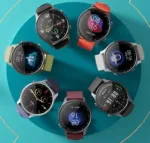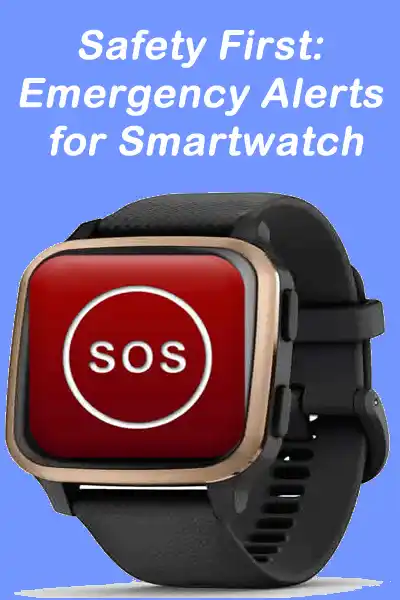Safety First: Using Your Smartwatch’s Emergency Features
Your smartwatch can be more than just a fitness tracker or notification center. Many smartwatches come equipped with powerful emergency features like SOS functions, fall detection, and medical ID, promoting safety and preparedness for everyone. A smartwatch with emergency alerts, including fall detection for seniors, promotes safety at home. Let’s explore how to leverage these features and ensure you or your loved ones have peace of mind.
Smartwatch with Emergency Alerts – SOS, Fall Detection, Medical ID
Emergency SOS:
Smartwatches can be lifesavers, especially for those who might find themselves in situations where they need to call for help quickly. Many smartwatches come with built-in SOS features or have compatible apps that can utilize the watch’s functionalities to send an alert to emergency contacts. Imagine a situation where you need immediate help but can’t reach your phone. A smartwatch with an emergency alert function can be a lifesaver. Here’s how to use it:
- Identify your watch’s SOS function: Most smartwatches have a dedicated SOS button or require a specific button combination press (hold, double press etc.). Consult your watch’s user manual for specific instructions.
- Triggering SOS: Activating SOS typically triggers a vibration or alarm to get your attention. You’ll then see an SOS screen where you can confirm you need help.
- Sending the Alert: Upon confirmation, your smartwatch will send an SOS message to your emergency contacts, often including your location data. This allows them to quickly find you and dispatch help if needed.
Here’s a breakdown of smartwatch SOS options:
Built-in SOS Features:
Many smartwatches, like the Apple Watch Series 4 and later models or select Samsung Galaxy Watches, have built-in SOS features. By triggering the SOS function (usually by pressing a button combination or holding a specific button for a few seconds), the watch will:
- Vibrate or make an alarm sound to get your attention.
- Display an SOS screen where you can confirm if you need help.
- If confirmed, send an SOS message to your emergency contacts with your location.
SOS Apps:
Third-party SOS apps offer similar functionalities, and sometimes even more features, than built-in SOS. Here are some popular SOS smartwatch apps:
- My SOS Family Emergency Alerts: This app allows for various SOS triggering methods such as:
- Double tapping the watch screen.
- Hands-free voice activation.
- Setting an SOS timer for risky situations.
- Linking with Alexa smart speakers for voice-activated SOS from any Alexa device.

My SOS Family Emergency Alerts app
- SOS Watch: This app offers a discreet SOS function disguised as a regular watch face. With a two-button press, it can:
- Send an SOS alert with your location via SMS to your emergency contacts.
- Sound an alarm on your smartphone for additional attention.
Important to Note:
- Always familiarize yourself with your smartwatch’s SOS features or app’s functionalities before needing them in an emergency.
- Fall detection is not perfect and there can be false positives. It’s important to be aware of this limitation and to test the feature out before relying on it completely.
- Not all smartwatches have built-in SOS features. Be sure to check the specifications of your watch before assuming it has this feature.
- If you are someone who might benefit from an SOS smartwatch app or built-in feature, it’s always a good idea to inform your emergency contacts so they are aware of how the system works.
Fall Detection (for Fall Alert Watches):
Falls are a major concern for seniors. A smartwatch with fall detection for seniors can provide peace of mind for both the wearer and their loved ones. Smartwatches can be lifesavers, especially for those at risk of falls. Many smartwatches come with built-in fall detection or have compatible apps that can utilize the watch’s sensors to detect a fall and send an alert to emergency contacts. Here’s how it works:
- Built-in Sensors: Fall alert watches for seniors utilize built-in motion sensors to detect sudden impacts that might indicate a fall.
- Automatic Alerts: If a fall is suspected, the watch will vibrate and display an alert. You’ll have the option to confirm you’re okay or initiate an SOS call.
- Emergency Response: If you don’t respond within a set timeframe, the watch can automatically send an SOS message with your location to your emergency contacts.
Here are some popular smartwatch apps with fall detection for seniors:
- Apple Watch: Apple Watch Series 4 and later models have built-in fall detection. When a fall is detected, the watch will vibrate, sound an alarm, and display an alert. You can then choose to swipe to contact emergency services or dismiss the alert.

Apple Watch
- Samsung Galaxy Watch: Select Samsung Galaxy Watches, like the Galaxy Watch 5 and Active series, also have built-in fall detection. When a fall is detected, the watch will vibrate and display an SOS option. You can tap SOS to send a message to your emergency contacts with your location.

Samsung Galaxy Watch
- My Medic Watch: This is a third-party app available for both Apple Watch and Android smartwatches. My Medic Watch uses the watch’s sensors to detect falls and can send alerts to emergency contacts, including your location. The app offers a free trial and then requires a monthly or yearly subscription.

My Medic Watch app
Important to Note:
- Fall detection is not perfect and there can be false positives. It’s important to be aware of this limitation and to test the feature out before relying on it completely.
- Not all smartwatches have fall detection. Be sure to check the specifications of your watch before assuming it has this feature.
- If you are concerned about falls, it is important to talk to your doctor. They can help you create a fall prevention plan.
Medical ID:
Every second counts in a medical emergency. A smartwatch with a medical ID feature can provide crucial information to first responders. Here’s how to set it up:
- Adding Medical Information: Through your smartwatch app, you can create a medical ID containing details like allergies, medications, and emergency contacts.
- Quick Access: Medical ID information is easily accessible by first responders, even if your watch is locked. This allows them to tailor medical care based on your specific needs.
There are two main ways to utilize a medical ID with your smartwatch:
- Built-in Medical ID: Some smartwatches, like newer Apple Watches, offer a built-in medical ID feature within their health app. You can access this through your watch or smartphone app to add details like allergies, medications, and emergency contacts. This information is then accessible on your watch’s lock screen, allowing first responders to view it quickly in an emergency.
- Third-Party Medical ID Apps: Many third-party apps offer medical ID functionality compatible with various smartwatches. These apps allow you to create a digital medical ID with similar information as the built-in option. The app might then display the ID on your watch face or offer access through a specific app screen.
Third-party Medical ID Apps for Smartwatch:
It’s important to note that while there are many third-party health and wellness apps available for smartwatches, finding dedicated medical ID apps can be trickier. Here’s why:
- Privacy Concerns: Medical information is highly sensitive, and some smartwatch platforms might restrict access to core functionalities needed for a robust medical ID app.
- Focus on Data Tracking: Many health and wellness apps focus on tracking health data (heart rate, sleep patterns) rather than storing static medical information like allergies or emergency contacts.
However, there are still a few options to consider that offer functionalities similar to a medical ID:
- Emergency Contact Apps: These apps allow you to store emergency contact information on your smartwatch. While not a full medical ID, it can provide crucial details to first responders in an emergency. Here are some examples:
- ICE (In Case of Emergency)
- HiThere
- Medical Information Apps: These apps might not be specifically designed for smartwatches, but some offer companion apps that can display the information on your watch face. These can be a good alternative, especially if the main app resides on your smartphone. Here are a few examples:
- MyID Medical ID
- Road ID
Important Considerations:
- App Compatibility: Always check if the app is compatible with your specific smartwatch model and operating system.
- Data Security: Research the app’s data security practices before storing any sensitive medical information.
- Not a Replacement for a Medical ID Bracelet: While these apps offer some functionality, they might not be as readily accessible as a traditional medical ID bracelet. Consider using both for maximum protection.
Remember:
- Familiarize Yourself: Before needing them in an emergency, take time to understand your smartwatch’s specific SOS functions, fall detection settings (if applicable), and medical ID setup process.
- Test and Practice: While we hope you never need them, test your SOS features and practice using your medical ID to ensure everything functions smoothly.
- Inform Your Contacts: Let your emergency contacts know you have a smartwatch with emergency features and how they might receive alerts.
Safety Through Technology:
By utilizing your smartwatch’s emergency SOS, fall detection (on fall alert watches), and medical ID features, you’re taking a proactive step towards safety and preparedness. Whether you’re looking for a smartwatch with emergency alert for yourself or a fall detection for seniors, these features can provide invaluable peace of mind.
Additional helpful information:
The best smartwatch health and wellness apps – Empower Your Wellness: Best Health and Fitness Smartwatch Apps
Use your smartwatch to improve your communication – Connect on Your Wrist: Best Communication Smartwatch Apps




